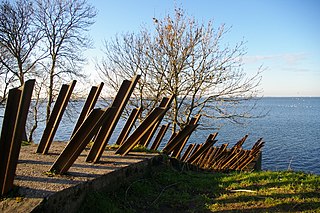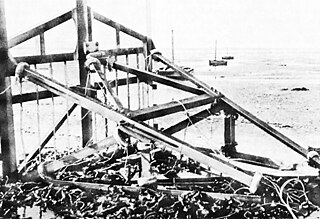 W
WAnti-tank obstacles include, but are not limited to:The Czech hedgehog and Dragon's teeth are the most famous types of World War II anti-tank obstacles. Anti-tank trenches were used on the western front during World War I. Anti-tank mines are the most common anti-tank obstacles.
 W
WAdmiralty scaffolding, also known as Obstacle Z.1 or sometimes simply given as beach scaffolding or anti-tank scaffolding, was a British design of anti-tank and anti-boat obstacle made of tubular steel. It was widely deployed on beaches of southern England, eastern England and the south western peninsula during the invasion crisis of 1940-1941. Scaffolding was also used, though more sparingly, inland.
 W
WAnti-tank trenches, also called anti-tank ditches, are ditches dug into and around fortified positions to hold up the advance of enemy tanks. Anti-tank ditches were first used in World War I by Germany in an effort to protect their trenches against the newly developed British tanks. An anti-tank ditch has to be wide enough and deep enough to prevent a tank from crossing. Armies have been known to disguise anti-tank ditches to enable the ditch to disable an enemy tank. Anti-tank trenches can be defeated by use of a fascine.
 W
WBuoy is a British type of anti-tank obstacle used to block roads intended to impede enemy movement. Buoys were widely deployed during the invasion crisis of 1940–1941. Each buoy was a truncated cone of concrete with a rounded bottom, about 2 feet 9 inches (84 cm) high, and with a 2 inches (50 mm) diameter hole through the axis. They would be placed in at least five rows across a roadway.
 W
WThe Cointet-element, also known as a Belgian Gate or C-element, was a heavy steel fence about three metres wide and two metres high, typically mounted on concrete rollers, used as a mobile anti-tank obstacle during World War II. Each individual fence element weighed about 1,280 kg but was movable through the use of two fixed and one rotating roller. Its invention is attributed to a French colonel, Léon-Edmond de Cointet de Fillain, who came up with the idea in 1933 during the run-up to World War II, as to be used in the Maginot Line. Besides their use as barricades to the entrances of forts, bridges and roads, the heavy fences are best known for their use in the Belgian Iron Wall of the KW-line and their re-use as beach obstacles on the Atlantikwall.
 W
WThe Czech hedgehog is a static anti-tank obstacle defense made of metal angle beams or I-beams. The hedgehog is very effective in keeping light to medium tanks and vehicles from penetrating a line of defense; it maintains its function even when tipped over by a nearby explosion. Although Czech hedgehogs may provide some scant cover for infantry, infantry forces are generally much less effective against fortified defensive positions than mechanized units.
 W
WDragon's teeth are square-pyramidal fortifications of reinforced concrete first used during the Second World War to impede the movement of tanks and mechanised infantry. The idea was to slow down and channel tanks into killing zones where they could easily be disposed of by anti-tank weapons.
 W
WA Jersey barrier, Jersey wall, or Jersey bump is a modular concrete or plastic barrier employed to separate lanes of traffic. It is designed to minimize vehicle damage in cases of incidental contact while still preventing vehicle crossovers resulting in a likely head-on collision. Jersey barriers are also used to reroute traffic and protect pedestrians and workers during highway construction. They are named after the U.S. state of New Jersey which first started using the barriers as separators between lanes of a highway in the 1950s.
 W
WThe Toblerone line is a 10 km long defensive line made of "dragon's teeth" built during the Second World War between Bassins and Prangins, in the Canton of Vaud, Switzerland. These lines of defensive blocks can be found all over Switzerland, though more commonly in border areas. Their purpose was to stop tank invasions. The 2,700 9-ton concrete blocks that make up the defenses are similar to the shape of the Toblerone chocolate bar, which gave its name to the line. Since the line has been left to nature since its construction, it was decided to keep these concrete blocks and to make a hiking trail along their route.